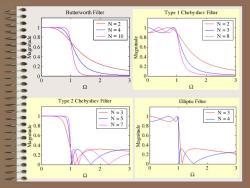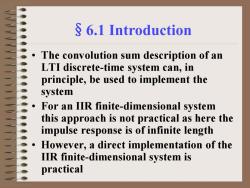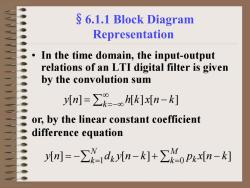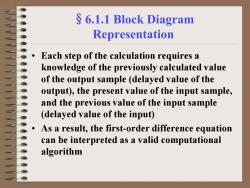电子科技大学:《数字信号处理 Digital Signal Processing》课程教学资源(课件讲稿)Chapter 06 Digital Filter Structures

Chapter 6 Digital Filter Structures
Chapter 6 Digital Filter Structures

Ha() Ha() 1+δ 1+e2 -Passband- Stopband- Passband- Stopband- 2 p Qs 0 s - Transition Transition band band ·2p-passband edge ·1/V(1+ε2)-Maximum frequency passband deviation ·2s-stopband edge frequency 1/A Maximum stopband ·δp-peak ripple magnitude value in the passband ·δs-peak ripple Transition ratio k=p/s value in the stopband k1=ε/V(A2-1)
• 1 / √(1 + ε2) - Maximum passband deviation • 1/A - Maximum stopband magnitude • Transition ratio k = Ωp/ Ωs • k1 = ε/ √(A2 -1) • Ωp - passband edge frequency • Ωs - stopband edge frequency • δp - peak ripple value in the passband • δs - peak ripple value in the stopband

Butterworth Filter Type 1 Chebyshev Filter N=2 N=2 N=4 N=3 N=10 0.8 N=8 0.6 0.4 0.2 0.2 0 2 3 0 2 2 2 Type 2 Cheby shev Filter Elliptic Filter N=3 N=3 N=5 N=4 0.8 N=7 0.8 opmuew 0.6 0.6 0.4 0.4 0.2 0.2 0 2 3 0 2 3
0 1 2 3 0 0.2 0.4 0.6 0.81 Ω Magnitude Butterworth Filter N = 2 N = 4 N = 10

§6.1 Introduction The convolution sum description of an LTI discrete-time system can,in principle,be used to implement the system For an IIR finite-dimensional system this approach is not practical as here the impulse response is of infinite length However,a direct implementation of the IIR finite-dimensional system is practical
• The convolution sum description of an LTI discrete-time system can, in principle, be used to implement the system • For an IIR finite-dimensional system this approach is not practical as here the impulse response is of infinite length • However, a direct implementation of the IIR finite-dimensional system is practical §6.1 Introduction

§6.l.1 Block Diagram Representation In the time domain,the input-output relations of an LTI digital filter is given by the convolution sum Hm=∑-hMk]n-k] or,by the linear constant coefficient difference equation [m=-∑1d[n-]+∑0Pkx[n-]
§6.1.1 Block Diagram Representation • In the time domain, the input-output relations of an LTI digital filter is given by the convolution sum ∑∞ =−∞ = − k y[n] h[k] x[n k] ∑ = ∑ = = − − + − M k k N k k y n d y n k p x n k 1 0 [ ] [ ] [ ] or, by the linear constant coefficient difference equation

§6.1.1 Block Diagram Representation For the implementation of an LTI digital filter, the input-output relationship must be described by a valid computational algorithm To illustrate what we mean by a computational algorithm,consider the causal first-order LTI digital filter shown below x y[n]
§6.1.1 Block Diagram Representation • For the implementation of an LTI digital filter, the input-output relationship must be described by a valid computational algorithm • To illustrate what we mean by a computational algorithm, consider the causal first-order LTI digital filter shown below

§6.1.1 Block Diagram Representation Each step of the calculation requires a knowledge of the previously calculated value of the output sample (delayed value of the output),the present value of the input sample, and the previous value of the input sample (delayed value of the input) As a result,the first-order difference equation can be interpreted as a valid computational algorithm
§6.1.1 Block Diagram Representation • Each step of the calculation requires a knowledge of the previously calculated value of the output sample (delayed value of the output), the present value of the input sample, and the previous value of the input sample (delayed value of the input) • As a result, the first-order difference equation can be interpreted as a valid computational algorithm

S 6.1.2 Basic Building Blocks The computational algorithm of an LTI digital filter can be conveniently represented in block diagram form using the basic building blocks shown below x[n] wn] Multiplier Adder x(n] xInl yn] Unit delay Pick-off node
§6.1.2 Basic Building Blocks • The computational algorithm of an LTI digital filter can be conveniently represented in block diagram form using the basic building blocks shown below x[n] y[n] w[n] + A x[n] y[n] y[n] −1 x[n] z x[n] x[n] x[n] Adder Unit delay Multiplier Pick-off node

6.1.3 Analysis of Block Diagrams Carried out by writing down the expressions for the output signals of each adder as a sum of its input signals,and developing a set of equations relating the filter input and output signals in terms of all internal signals Eliminating the unwanted internal variables then results in the expression for the output signal as a function of the input signal and the filter parameters that are the multiplier coefficients
§6.1.3 Analysis of Block Diagrams • Carried out by writing down the expressions for the output signals of each adder as a sum of its input signals, and developing a set of equations relating the filter input and output signals in terms of all internal signals • Eliminating the unwanted internal variables then results in the expression for the output signal as a function of the input signal and the filter parameters that are the multiplier coefficients

6.2 Equivalent Structures Two digital filter structures are defined to be equivalent if they have the same transfer function We describe next a number of methods for the generation of equivalent structures However,a fairly simple way to generate an equivalent structure from a given realization is via the transpose operation
§6.2 Equivalent Structures • Two digital filter structures are defined to be equivalent if they have the same transfer function • We describe next a number of methods for the generation of equivalent structures • However, a fairly simple way to generate an equivalent structure from a given realization is via the transpose operation
按次数下载不扣除下载券;
注册用户24小时内重复下载只扣除一次;
顺序:VIP每日次数-->可用次数-->下载券;
- 电子科技大学:《数字信号处理 Digital Signal Processing》课程教学资源(课件讲稿)Chapter 05 Digital Processing of Continuous-Time Signals.pdf
- 电子科技大学:《数字信号处理 Digital Signal Processing》课程教学资源(课件讲稿)Chapter 04 Frequency-domain Representation of LTI Discrete-Time Systems.pdf
- 电子科技大学:《数字信号处理 Digital Signal Processing》课程教学资源(课件讲稿)Chapter 03 Transform-Domain Representation of Discrete-Time Signals.pdf
- 电子科技大学:《数字信号处理 Digital Signal Processing》课程教学资源(课件讲稿)Chapter 02 Discrete-Time Signals and Systems.pdf
- 电子科技大学:《数字信号处理 Digital Signal Processing》课程教学资源(课件讲稿)Chapter 01 Continuous-time Signals and Systems.pdf
- 电子科技大学:《数字信号处理 Digital Signal Processing》课程教学资源(课件讲稿)Chapter 00 Introduction.pdf
- 电子科技大学:《微电子器件》课程教学资源(思政教案)高频晶体管设计.pdf
- 电子科技大学:《微电子器件》课程教学资源(思政教案)MOSFET发展方向.pdf
- 电子科技大学:《微电子器件》课程教学资源(思政教案)大注入效应.pdf
- 电子科技大学:《微电子器件》课程教学资源(思政教案)绪论、微电子技术发展现状.pdf
- 电子科技大学:《微电子器件》课程教学资源(教学大纲)Microelectronic Devices.pdf
- 电子科技大学:《移动通信系统》课程教学资源(课件讲稿)第七章 未来移动通信系统及其增强技术.pdf
- 电子科技大学:《移动通信系统》课程教学资源(课件讲稿)第四章 抗衰落和链路性能增强技术.pdf
- 电子科技大学:《移动通信系统》课程教学资源(课件讲稿)第六章 GSM及其增强移动通信系统.pdf
- 电子科技大学:《移动通信系统》课程教学资源(课件讲稿)第五章 蜂窝组网技术(移动通信网的基本概念、频率复用和蜂窝小区、多址接入技术).pdf
- 电子科技大学:《移动通信系统》课程教学资源(课件讲稿)第二章 移动通信电波传播与传播预测模型.pdf
- 电子科技大学:《移动通信系统》课程教学资源(课件讲稿)第三章 移动通信中的信源编码和调制解调技术.pdf
- 电子科技大学:《移动通信系统》课程教学资源(课件讲稿)第一章 概述(主讲:雷霞).pdf
- 电子科技大学:《移动通信系统》课程教学资源(授课电子教案,雷霞).pdf
- 电子科技大学:《移动通信系统》课程教学资源(思政案例选录).pdf
- 电子科技大学:《数字信号处理 Digital Signal Processing》课程教学资源(课件讲稿)Chapter 07 Digital Filter Design.pdf
- 电子科技大学:《数字信号处理 Digital Signal Processing》课程教学资源(课件讲稿)Chapter 09 Analysis of Finite Wordlength Effects.pdf
- 电子科技大学:《数字信号处理 Digital Signal Processing》课程教学资源(课件讲稿)Chapter 10 Multirate Digital Signal Processing.pdf
- 电子科技大学:《数字信号处理 Digital Signal Processing》课程教学资源(课件讲稿)Chapter 11 Applications of Digital Signal Processing.pdf
- 电子科技大学:《数字通信基础 Digital Communications》课程教学资源(课件讲稿,图片版)About.pdf
- 电子科技大学:《数字通信基础 Digital Communications》课程教学资源(课件讲稿,图片版)Chapter 01 Introduction 1.1 Exampls.pdf
- 电子科技大学:《数字通信基础 Digital Communications》课程教学资源(课件讲稿,图片版)Chapter 01 Introduction 1.2 Diagram and elements of Comm.Sys.pdf
- 电子科技大学:《数字通信基础 Digital Communications》课程教学资源(课件讲稿,图片版)Chapter 01 Introduction 1.3 Digital Comm.Sys.pdf
- 电子科技大学:《数字通信基础 Digital Communications》课程教学资源(课件讲稿,图片版)Chapter 01 Introduction 1.4 Channels and their characteristics.pdf
- 电子科技大学:《数字通信基础 Digital Communications》课程教学资源(课件讲稿,图片版)Chapter 04 Information source and source coding 4.1 ADC and PCM.pdf
- 电子科技大学:《数字通信基础 Digital Communications》课程教学资源(课件讲稿,图片版)Chapter 04 Information source and source coding 4.2 Modeling of digital source.pdf
- 电子科技大学:《数字通信基础 Digital Communications》课程教学资源(课件讲稿,图片版)Chapter 05 Digital transmission through the AWGN channel 5.1 Geometric rep.of the sig waveforms.pdf
- 电子科技大学:《数字通信基础 Digital Communications》课程教学资源(课件讲稿,图片版)Chapter 05 Digital transmission through the AWGN channel 5.2 Pulse amplitude modulation.pdf
- 电子科技大学:《数字通信基础 Digital Communications》课程教学资源(课件讲稿,图片版)Chapter 05 Digital transmission through the AWGN channel 5.3 2-d signal waveforms.pdf
- 电子科技大学:《数字通信基础 Digital Communications》课程教学资源(课件讲稿,图片版)Chapter 05 Digital transmission through the AWGN channel 5.4 M-d signal waveforms.pdf
- 电子科技大学:《数字通信基础 Digital Communications》课程教学资源(课件讲稿,图片版)Chapter 05 Digital transmission through the AWGN channel 5.5 Opt.reception for the sig.in AWGN.pdf
- 电子科技大学:《数字通信基础 Digital Communications》课程教学资源(课件讲稿,图片版)Chapter 05 Digital transmission through the AWGN channel 5.5.2 Opt.reception for the sig.in AWGN.pdf
- 电子科技大学:《数字通信基础 Digital Communications》课程教学资源(课件讲稿,图片版)Chapter 05 Digital transmission through the AWGN channel 5.5.3 Opt.reception for the sig.in AWGN.pdf
- 电子科技大学:《数字通信基础 Digital Communications》课程教学资源(课件讲稿,图片版)Chapter 05 Digital transmission through the AWGN channel 5.6.1 Optimal receivers and probs of err.pdf
- 电子科技大学:《数字通信基础 Digital Communications》课程教学资源(课件讲稿,图片版)Chapter 05 Digital transmission through the AWGN channel 5.6.2 Optimal receivers and probs of err.pdf
